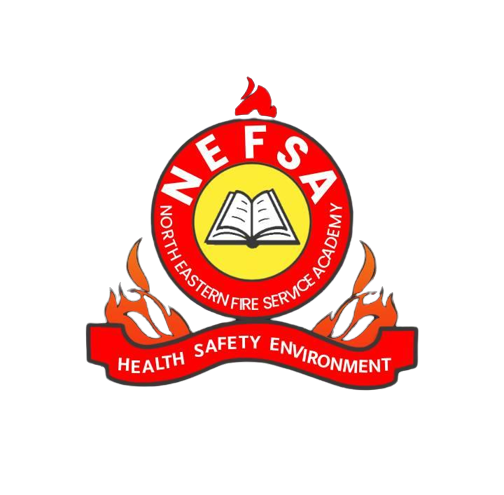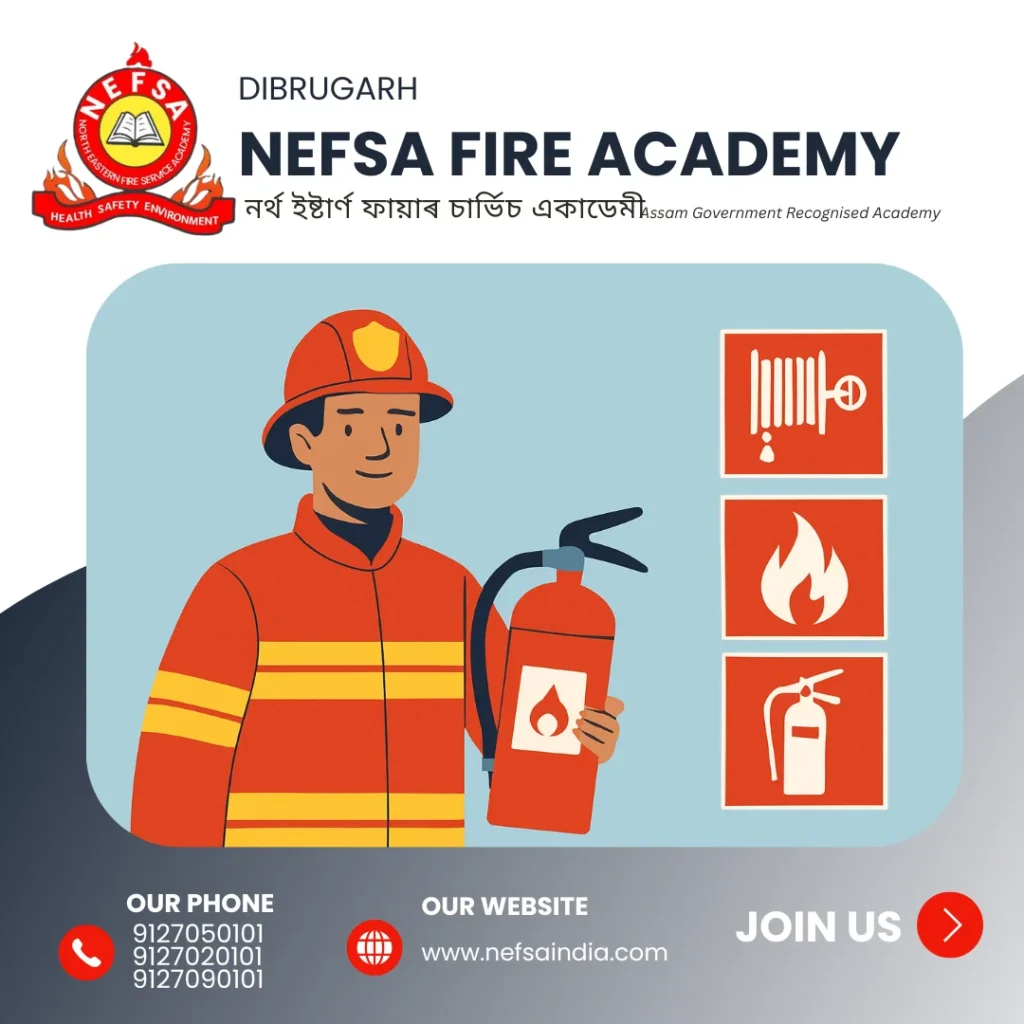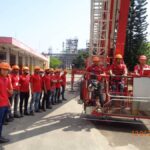Fire safety and emergency response careers are in growing demand across India from hospitals and airports to industry and municipal services. Many cities and institutions are expanding fire-safety teams and creating new posts, raising strong career prospects for trained graduates.
If you’re prepared for hands-on work, teamwork, and fast decision-making, a professionally accredited training program can turn that willingness into a dependable, long-term profession. NEFSA (North Eastern Fire Service Academy) in Dibrugarh positions itself as a regionally focused, job-oriented training centre for those exact roles.
What is NEFSA ?
NEFSA – North Eastern Fire Service Academy is a Dibrugarh-based fire & safety training institute that offers government-recognized, career-focused programs with practical/live-fire training and placement support. The academy markets itself as a centre for hands-on firefighter and industrial safety training for the Northeast region.
Courses & curriculum what you’ll actually learn?
Typical NEFSA programs cover progressive training levels from basic fire safety and first-response skills to advanced firefighting, industrial fire & safety management, and disaster preparedness. Common modules across reputable fire-safety courses include:
-
Fire science basics: combustion, fire behavior, classes of fire.
-
Firefighting skills: hose handling, breathing apparatus, pumps, ladders, live-fire drills.
-
Fire prevention & detection: alarms, smoke control, hydrants, sprinkler systems.
-
Industrial safety & risk assessment: hot-work permits, confined-space entry, hazardous materials basics.
-
Emergency planning & incident command: evacuation procedures, mock drills, rescue coordination.
-
Legal & standards framework: statutory requirements and compliance.
These themes align with national training frameworks and vocational syllabi for fire safety (see Directorate General of Training standards and CTS syllabi).
How NEFSA prepares you for employment?
NEFSA emphasizes practical, live-fire training, simulation drills, and placement assistance. The academy advertises government-recognized certificates and claims job-focused batches with campus placement support for graduates. If getting job-ready skills – not just theory — is your priority, this hands-on approach is essential.
Career paths after NEFSA where graduates go
Graduates of fire & safety programs commonly find roles in:
-
Municipal fire services and state fire departments (firefighter, sub-officer).
-
Industrial safety roles at manufacturing plants, refineries, and large-scale factories.
-
Fire safety officer / safety supervisor roles in construction, hospitals, airports, metro rail, and educational campuses.
-
Emergency response teams, private firefighting contractors, and safety consulting firms.
Hiring across public and private sectors is growing partly because many municipal and institutional services are filling critical vacancies. This demand creates opportunity for trained candidates.
Pay & advancement
Salaries vary widely by sector, experience, and location. Entry-level posted figures for fire/facility safety roles in private industry often start modestly (₹20k–₹40k/month as early-career ranges reported by job listings and industry aggregators), while government or large PSU roles use formal pay scales and can offer pensions, allowances, and faster stability. Senior safety managers and specialized consultants can earn significantly more with experience and certifications. Always check specific job ads and government notifications for up-to-date pay scales.
Who should apply eligibility & fitness?
Most diploma/short-term fire-safety courses require 10th or 12th pass (requirements vary by program). Firefighter and operational roles also require good physical fitness, stamina, and the ability to work shifts and in hazardous conditions. Many advanced programs or supervisory roles prefer a diploma/degree in safety engineering or relevant experience. Consult the specific NEFSA course page or brochure for exact eligibility.
How to evaluate NEFSA (or any fire academy) before enrolling?
Before enrolling, check the following:
-
Recognition & certificates: Is the course recognized by a government body or accredited training board? (DGT/NCVET, state authorities, or industry bodies).
-
Hands-on training: Does the syllabus include live-fire drills, breathing apparatus training, pump and ladder practice, and evacuation exercises?
-
Placement record & employer links: Ask for recent placement statistics and employer tie-ups. NEFSA publishes placement claims request details.
-
Batch size & faculty: Small batches and experienced instructors with operational fire-service background are preferable.
-
Infrastructure & safety: Visit (if possible) to inspect training ground, equipment, and safety protocols.
-
Alumni feedback: Look for independent reviews or alumni testimonials on social media and job portals. Facebook+1
Typical program duration & costs
Program durations vary from short certificate courses (few weeks) up to 1-year diplomas. Fees depend on course level and facilities — short courses are affordable while advanced diplomas cost more. For accurate, current fees ask NEFSA directly via their admissions/placement page or official contacts.
Safety qualifications that boost employability
To stand out when applying, consider combining your NEFSA training with recognized add-ons:
-
First Aid / Basic Life Support (BLS) certifications
-
Confined Space Entry & Rescue training
-
Hazardous Materials (HAZMAT) awareness courses
-
Fire prevention & audit certification
-
Industrial safety diploma/degree (if aiming for corporate or managerial roles)
National training standards and the DGT competence frameworks highlight these areas as valuable.
FAQs (SEO-friendly quick answers)
Q: Is NEFSA government-recognized?
A: NEFSA advertises government-recognized courses and a registered training setup always confirm recognition for the specific course you choose.
Q: How long before I can get a job?
A: Short certificate learners may enter entry-level roles quickly; diploma graduates typically access more structured roles. Placement depends on local demand and your fitness/skills.
Q: What are typical entry requirements?
A: Many programs accept 10th/12th pass candidates; advanced courses require diplomas or degrees. Physical fitness tests are common for operational roles.
Q: Can I later specialize?
A: Yes , you can move into industrial safety management, fire engineering, HAZMAT, or training roles with additional certification and experience.
Q: Are placements guaranteed?
A: No legitimate academy can legally guarantee jobs for every student. Look for placement stats and employer tie-ups as indicators of outcomes.
Actionable next steps how to apply?
-
Visit NEFSA’s official site and placement/admissions page to view courses and contact details.
-
Request the course brochure, batch start dates, and an itemized fee schedule.
-
Ask for recent placement stats and employer names for the batch you’ll join.
-
If possible, attend an open day or speak to alumni to confirm training quality.
Sources / Further reading
-
NEFSA official site — North Eastern Fire Service Academy (programs, admissions). nefsaindia.com
-
NEFSA placement & admissions page (course claims & placements). nefsaindia.com
-
Directorate General of Training — Fire Technology & Industrial Safety (CTS / syllabus guidance). Directorate General of Training
-
Times of India: reports on fire services staffing and new fire officer posts (context for demand). The Times of India
-
Glassdoor / industry salary pages for fire & safety roles (salary ranges & expectations). Glassdoor
Conclusion
If you’re ready to start a career that saves lives and keeps people safe, NEFSA is a strong regional option for hands-on fire & safety training in Northeast India. Visit NEFSA’s admissions page, review the course brochure, and book a seat in the next batch then begin practical training that employers value.







